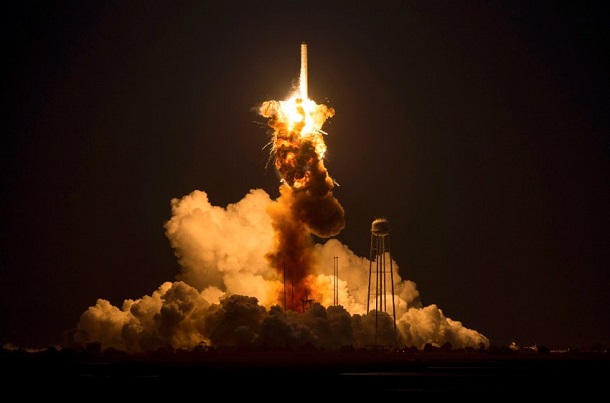The inferno at the launch pad in Virginia will cost at least $ 200 million. The unmanned cargo spacecraft “Cygnus” had exploded at the start. However, the supply of the ISS should not be compromised.
The “Cygnus” -Versorgungsmission for the International Space Station has come to spectacular fiasco on Tuesday night: A few seconds after the start in Wallops in the US state of Virginia exploded the carrier rocket “Antares”, the unmanned space shuttle into space should shoot. According to the US space agency Nasa there were no injuries. “Absolutely urgently” needed supplies for the ISS crew had not been destroyed by the inferno.
The “Antares” rocket was fired at 18.22 local time clock (clock 23.22 CET) and moments later following a “catastrophic irregularity” shattered, as the NASA control station announced. The exact cause was initially unclear. The rocket exploded in the air and then fell back to earth. Upon impact, it must have come again to an explosion, according to the images: The images show how piles up a ball of fire and sparks.
The space freighter to the private company Orbital Sciences should take about 2.2 tons of material to the International Space Station ISS – as much as in any of the previous missions. For cargo included food for the astronauts stationed on the ISS and scientific instruments, including numerous small satellites.
Frank Culbertson, Manager at Orbital Sciences, said that the problems had begun ten to twelve seconds after the start. After 20 seconds it was all over. The ground staff had given after an initial explosion the command to complete destruction of the aircraft. With such a measure should be about preventing rocket parts to strike at populated area. Now it was a matter of repairing the launch ramp “as soon as possible”.
How long last the repairs and the search for the cause of the crash, one can not say at present. After Culbertson statement the mission with more than $ 200 million was insured. Added to this came the repair costs.
Explosion of the space shuttle “Cygnus”:Independent from Russia in 2017
“We will hopefully soon understand what happened,” said Orbital Sciences CEO Culbertson after the explosion. “We have all experienced in our industry, and we have seen how other teams have recovered from it – and we will.”
In the six ISS astronauts are currently stationed. Three of them, including the German Alexander Gerst, are expected to return in two weeks after 165 days on the ISS to Earth. Their successors, a Russian cosmonaut and two US astronauts are scheduled to arrive two weeks later on the space station. “The team is in no danger,” said William Gerstenmaier, NASA’s top managers after the accident. The freight on board “Cygnus” is for the crew of the ISS “not necessary”.
NASA had ended its shuttle program in 2011 after about 30 years. Since then, US astronauts are dependent on Russian space capsules. To supply the astronauts and for the supply of scientific equipment ever since the US put on private companies.
As part of the nearly two billion dollar contract there should be until 2016 at least seven other “Cygnus” missions. In addition to “Cygnus” NASA uses on the space freighter “Dragon” from SpaceX. The next launch of “Dragon” was planned in December, said the Nasa with.
From 2017, the US wants to fly its astronauts back even to the International Space Station ISS. The dependence on Russian “Soyuz” capsules should then be completed. The NASA relies on the private sector: With the development of transport shuttles US firms Boeing and SpaceX were commissioned.


